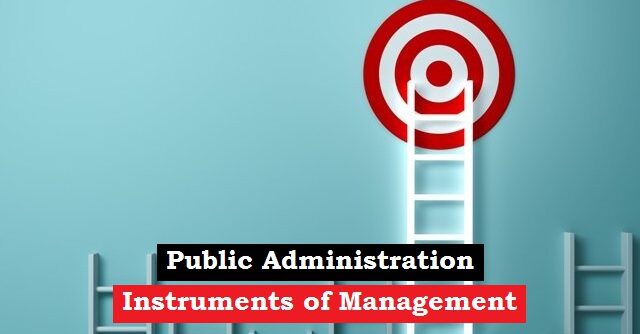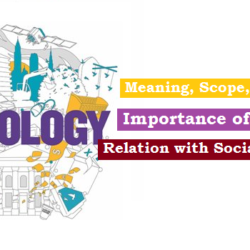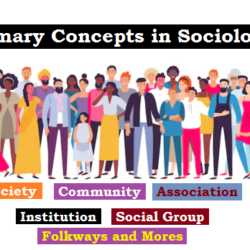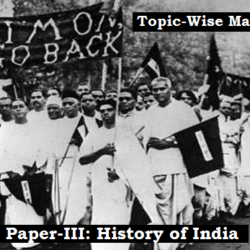
Co-ordination
Co-ordination is the integration of several parts into an orderly whole to achieve the desired objectives.
- Sub-division of work is inescapable, therefore coordination becomes mandatory.
- Coordination can be achieved by:
- Allotting them to people appropriately placed in the structure.
- Motivation so that each works voluntarily fits his task into the system.
- It does not develop by accident but must be won by intelligent, vigorous, persistent and organized efforts.
Necessity of Coordination:
- To eliminate conflict
- To eliminate unhealthy competition
- To ensure economy and efficiency
- To achieve the desired goals
Techniques of Coordination:
- Planning: to ensure optimum returns from the available resources within the stipulated time frame
- Consultation: it is always better to consult in advance and ensure proper decision when a decision would infringe upon the working of any other department
- Conferences and committees: provide a forum of exchange of opinion and facilitate a common program of action
- Standardization of procedures: stipulate the common course of action to be followed by different agencies
- Written instructions: provide clear instructions to be followed
Hindrances to Coordination:
The success or failure of an organization depends upon the effective measures initiated to ensure effective coordination. However, coordination in many organizations may suffer due to uncertainty about the future, lack of knowledge and experience, poor planning, size of the organization and number of variables that need to be integrated.
Delegation
Delegation is the grant or conferment of authority by a superior to a subordinate (or equal authorities) for the accomplishment of a particular assignment.
Line and Staff Agency: Line agency performs in order to accomplish the purpose by implementing policies laid down. Staff agency has no authority and deals with research and advisory functions only.
Types of Delegation:
- Downward: when a higher authority delegates to lower authority (e.g. sales manager to salesman)
- Upward: when a lower authority delegates to higher authority (e.g. share holders to board of directors)
- Sideward: delegation at an equal level (e.g. work distribution among peers)
Characteristics of Delegation:
- It is subject to policy, rules and regulations framed by delegating authority.
- Delegating authority at the same time retains the authority.
- Delegation implies partial delegation of authority as the delegator does not delegate his entire authority.
- It is subject to variance- can be enhanced, reduced or withdrawn.
Need of Delegation:
- Increasing volume of work
- Complexity (operational procedure, rules and regulations)
- Time saving (for policy and planning)
- Development of sub ordinates (e.g. sharing responsibility, self advancement)
- Flexibility in organization (to deal with changes in organization)
- Economy and efficiency
- Effective management (to counter geographical dispersions)
Principles of Delegation:
- Well defined authority
- Written form and clear limitations
- Authority and responsibility should go as co-equal
- Superior cannot avoid his responsibility
- Unity of command
- Open communication (for providing necessary help and guidance)
- Succeeded by appraisal of the performance
- Positional delegation and not to an individual
Communication
Communication is the process of affecting an inter-change of understand between people
Pfiffner considers it as ‘the heart of management’. Millet describes it as the ‘blood stream of an organization’.
Elements of Communication:
- Communicator: speaker or sender
- Transmission procedure: mail, phone, etc
- Form of communication: order, letter, report, etc
- Recipient: receiver
- Desired response: as evidence of compliance
Essentials of Communication:
- Clarification of ideas before communicating
- Objective of communication
- Adequate information
- Sufficient time to act upon
- Sufficient flexibility
- Stimulation by referring to previous agreements, etc
Factors inhibiting Communication:
- Rigidity: instead of a rigid stand, listening to others and accommodating views led to effective communication
- Generalization: painting everyone equal out of a bad experience discourages effective communication
- Extreme opinion: branding everything as good or bad inhibit communication
Supervision
It is an act of overseeing and guiding the activities of subordinates by their superiors.
Guiding and advising subordinates while supervising is positive supervision. While directing, investigating when supervising is negative supervision.
Aspects of Supervision:
- Substantive or technical: a supervisor must know the techniques and know-how of his work before planning and assigning duties.
- Institutional aspect: he has to follow established rule and procedures.
- Personal aspect: he has to create interest and enthusiasm among the workers. He must be humane, sympathetic and possesses the art of human relationship.
Qualities of a Supervisor:
- Thoroughness: possessing all the required information
- Fairness: sense of justice, truthfulness
- Initiative: courage, confidence, decisiveness
- Tact: win loyalty and support
- Emotional control: channel them in right direction
- Human relation: personal and humane relationship
Duties of a Supervisor:
- To understand the duties and responsibilities of his own position
- To plan the execution of work
- To divide the work among subordinates
- To train the subordinates in the respective field
- To evaluate and monitor the performance of subordinates
- To correct mistakes and solve problems
- To keep informed about the policies
- To cooperate with the colleagues and seek advice when needed
- To deal with complaints and suggestions
Motivation
Social psychological approach is a tool to understand the relationship between mean and the organization. It can answer- why people work in organization!
Theories of Motivation:
- Maslow’s Need Hierarchy Theory of Motivation
- McGregor’s Theory X and Y of Motivation
Maslow’s Theory of Motivation:
- Human beings become members of organization to fulfill their needs.
- Fulfillment of these needs motivates them to a higher level of performance.
- Maslow arranged a person’s motivational needs in a hierarchical manner:
- Physiological (hunger and shelter)
- Security (job security)
- Social (relationship)
- Esteem (power, status)
- Self actualization (satisfaction, potential fulfillment)
- Non-achievement of a particular goal motivates a person to achieve it. Once it is achieved, it no longer motivates a person to work further.
Criticism of Need Hierarchy Theory:
Absence of co-relation between satisfaction of needs at one level and activation of needs at next higher level is criticized.
Though there are limitations in Maslow’s conceptualization, his theory is helpful in predicting human behaviour on a low or high probability, if not in absolute terms.
McGregor’s Theory X: Traditional view of management
- Management is viewed as the master of an enterprise in directing economic activity and allocating resources.
- Hence, the management needs to control the behaviour of people in the organization to accomplish the purpose of the organization.
- This theory is based on few assumptions about human nature:
- Human being is lazy, has inherent dislike for work.
- Human being must be coerced to get adequate efforts.
- He prefers to be directed, wishes to avoid responsibility (lack of ambition)
Criticism of Theory X:
- It explains the management strategy. It does not explain as to which factors motivates the employees.
- Manager has to spend a great part of time on direction and control (leaves little time for policy and planning).
- McGregor felt that this view is helpful neighed to achieve the goals not to motivate the employees.
- Assumptions of the theory are inadequate to realise all the human potentials.
McGregor’s Theory Y: New theory of management
- Management is responsible for coordinating the activities in organization.
- Replacement of direction and control by integration- both organization and individual needs are integrated.
- It is an invitation to innovation (delegation, decentralization with proper appraisal system)
- It emphasizes developing and improving performance orientation of people working in the organization.
- This theory is based on few assumptions about human nature:
- Depending upon controllable conditions, work may be a source of satisfaction or punishment.
- Human being exercise self-direction and self-control.
- Average human beings learn to seek responsibility.
- The capacity to exercise a high degree of creativity is widely distributed among population.
- The intellectual potentialities of average human being are only partially utilized.

 Home
Home Syllabus
Syllabus Contact Us
Contact Us




